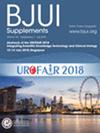中危非肌侵性膀胱癌维持治疗的价值
IF 4.4
2区 医学
Q1 UROLOGY & NEPHROLOGY
引用次数: 0
摘要
目的评估基于国际膀胱癌组(IBCG)风险分层的中等风险非肌肉浸润性膀胱癌(IR - NMIBC)患者中哪些亚组从维持治疗中获益,因为维持疗程在IR - NMIBC患者中的作用尚存争议。患者和方法:我们依赖于一个前瞻性维护的IR - NMIBC患者数据库,这些患者接受了膀胱内化疗或卡介苗(BCG)(2010-2023)。根据IBCG预后算法(无、1 - 2、3个或更多危险因素)对患者进行分层。所有患者在经尿道膀胱肿瘤切除术后至少接受了6次诱导滴注。根据IBCG风险组分层,我们使用3个月的里程碑式叠加累积发病率和多变量Cox回归模型来评估维持疗程的复发和进展风险。结果464例患者中,205例(44%)接受卡介苗治疗,259例(56%)接受膀胱内化疗。维持注射次数的中位数(四分位数间距)为9(5-11)。在中位随访57个月期间,139例(30%)患者复发。根据治疗时间,无IBCG危险因素的患者5年疾病复发的风险相似(7.7% vs 7.3%;风险比[HR] 0.78, 95%可信区间[CI] 0.49-1.37,分别为仅诱导与诱导加维持),而具有1 - 2个(5年风险:16% vs 13%; HR 0.65, 95% CI 0.48-0.82)或3个或以上IBCG危险因素的患者(5年风险:21% vs 17%;HR 0.48, 95% CI 0.25-0.85)与诱导加维持疗程治疗的复发风险较低相关。结论IBCG算法根据复发风险对IR - NMIBC患者进行了有效的分层。在这个观察性队列中,维持治疗与有一到两个或三个或更多IBCG危险因素的患者的复发率较低相关,但与没有危险因素的患者无关。这些发现表明,IBCG分层可以为IR - NMIBC患者的风险适应治疗决策提供信息。本文章由计算机程序翻译,如有差异,请以英文原文为准。
The value of maintenance therapy in intermediate‐risk non‐muscle‐invasive bladder cancer
ObjectiveTo evaluate which subgroups of patients with intermediate‐risk non‐muscle‐invasive bladder cancer (IR‐NMIBC) benefit from maintenance therapy based on the International Bladder Cancer Group (IBCG) risk stratification, as the role of a maintenance course in patients with IR‐NMIBC is debated.Patients and MethodsWe relied on a prospectively maintained database of patients with IR‐NMIBC who received intravesical chemotherapy or Bacillus Calmette–Guérin (BCG) (2010–2023). Patients were stratified according the IBCG prognostic algorithm (no, one to two, and three or more risk factors). All patients received at least six induction instillations after index transurethral resection of bladder tumour. We used 3‐month landmark stacked cumulative incidence and multivariable Cox regression models to assess the benefit from a maintenance course in terms of risk of recurrence and progression according to the IBCG risk groups stratification.ResultsAmong 464 patients, 205 (44%) received BCG treatment and 259 (56%) received intravesical chemotherapy. The median (interquartile range) number of maintenance instillations was 9 (5–11). Over a median follow‐up of 57 months, 139 (30%) patients had a recurrence. Patients with no IBCG risk factors had a similar risk of 5‐year disease recurrence according to treatment duration (7.7% vs 7.3%; hazard ratio [HR] 0.78, 95% confidence interval [CI] 0.49–1.37, for induction only vs induction plus maintenance, respectively), whereas patients with one to two (5‐year risk: 16% vs 13%; HR 0.65, 95% CI 0.48–0.82) or three or more IBCG risk factors (5‐year risk: 21% vs 17%; HR 0.48, 95% CI 0.25–0.85) were associated with lower hazards of recurrence if treated with an induction plus maintenance course.ConclusionsThe IBCG algorithm effectively stratifies patients with IR‐NMIBC by recurrence risk. In this observational cohort, maintenance therapy was associated with lower recurrence rates in patients with one to two or three or more IBCG risk factors, but not in those with no risk factors. These findings suggest that the IBCG stratification may inform risk‐adapted treatment decisions in patients with IR‐NMIBC.
求助全文
通过发布文献求助,成功后即可免费获取论文全文。
去求助
来源期刊

BJU International
医学-泌尿学与肾脏学
CiteScore
9.10
自引率
4.40%
发文量
262
审稿时长
1 months
期刊介绍:
BJUI is one of the most highly respected medical journals in the world, with a truly international range of published papers and appeal. Every issue gives invaluable practical information in the form of original articles, reviews, comments, surgical education articles, and translational science articles in the field of urology. BJUI employs topical sections, and is in full colour, making it easier to browse or search for something specific.
 求助内容:
求助内容: 应助结果提醒方式:
应助结果提醒方式:


